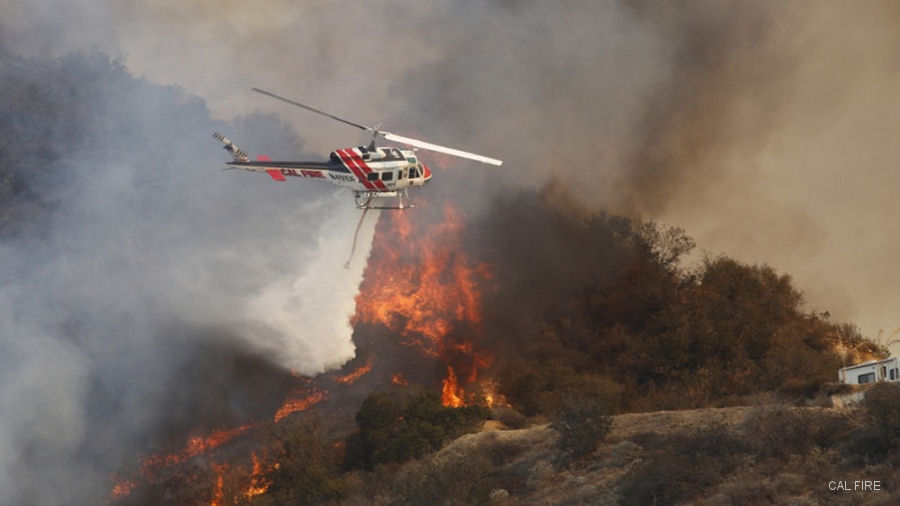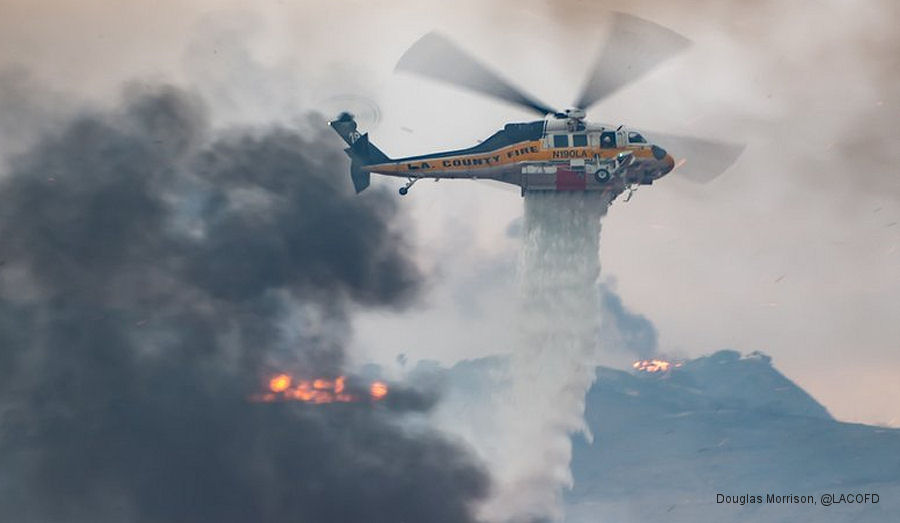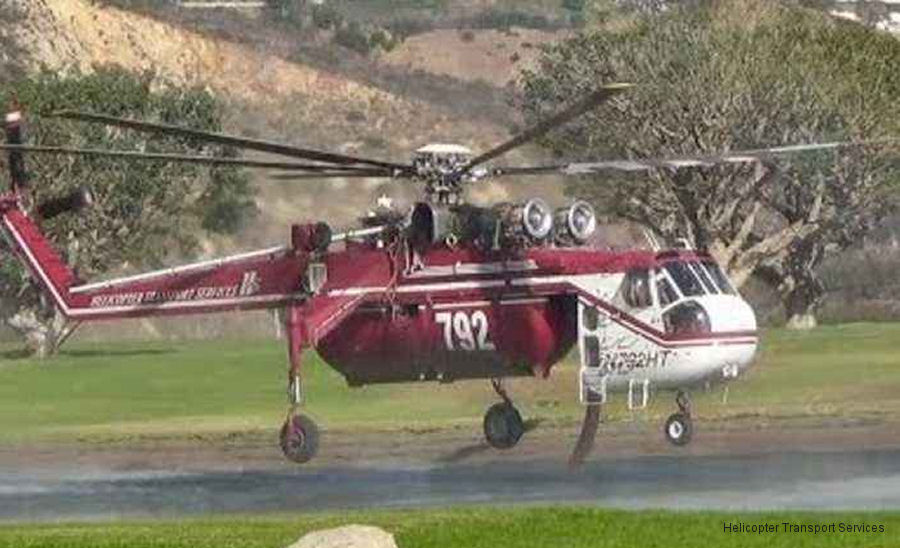
HAI, November 16, 2018 - As California experiences two of the most devastating fires in its history, helicopter crews are working long days to assist with battling the massive conflagrations.
There are currently 22 helicopter crews working on the Woolsey Fire that is ravaging Southern California, and another 21 crews fighting the Camp Fire in Northern California.
“Helicopters are very much like a multitool for incident commanders to use in a variety of missions when fighting these massive fires,” said Matt Zuccaro, president and CEO of Helicopter Association International (HAI). “Helicopters crews can directly attack the fire using water or retardant; they can quickly deploy firefighters or supplies to remote areas; they can serve as an observation post or direct air traffic; or they provide search-and-rescue or air ambulance services as needed. If needed, some helicopters can even switch between roles over the course of a day.”
HAI represents the commercial and civil helicopter industry, and several of the association’s member companies are currently assisting with the California fires, including Erickson, Helimax Aviation, Columbia Helicopters, and CHI Aviation.
Government agencies such as the U.S. Forest Service and California Department of Forestry and Fire Protection (Cal Fire) designate helicopters working on forest fires into three classes:
- Type I helicopters are the largest, capable of carrying hundreds or thousands of gallons of water or retardant, and are typically used to attack the fire directly. Depending on the aircraft configuration, Type I helicopters may also carry firefighters or supplies.
- Type II helicopters are medium-size aircraft. They typically carry hundreds of gallons of water to fight fires and quite often carry firefighters out to the fire lines.
- The category for smaller aircraft, Type III helicopters are used for reconnaissance, air traffic control, or moving crews or supplies in smaller numbers.
There are currently 11 Type I and 10 Type II helicopters working on the Camp Fire, which has destroyed the community of Paradise in Northern California. The helicopters are working from a helibase near Oroville. In the L.A. basin, there are nine Type I, nine Type II, and four Type III helicopters working on the Woolsey fire. The aircraft are operating out of the Camarillo airport.
“Right now, Columbia Helicopters has five Chinooks fighting fire in California,” said Keith Saylor, director of commercial operations for the company. “We have two Chinooks working on the Woolsey Fire, two Chinooks working on the Camp Fire, and the fifth Chinook is assigned to perform initial attack operations in the Sacramento area. We have overcrewed our aircraft, so we’re able to fly every available minute of the day without worrying about exceeding the mandatory crew rest periods.”
“We have three Aircranes flying on the fires in Southern California,” said Chris Schuldt, chief of staff and senior director at Erickson. The distinctive orange of Erickson’s Aircranes are a familiar sight during fire season in California, and the company’s aircraft routinely deploy to fight wildland fires in Australia, Europe, and Asia.
Helicopters attacking fires directly have several options available for deploying water or retardants. Traditionally, helicopters carried large buckets slung below the aircraft, and the modern Bambi Buckets of today offer features such as self-filling buckets and variable dispersion rates. Typically carried up to 200 feet below a helicopter, the technologically advanced buckets permit pilots to fill from tree-lined streams or ponds, and the self-filling feature allows crews to fill from water sources as shallow as 18 inches.
Tanked helicopters use either internal or external tanks. Again, the tanks range in size from hundreds to thousands of gallons, depending on the size and capability of the helicopter. Pilots fill the tanks using powered snorkels or by skimming across the surface of a water source.
Regardless of whether a crew is using tanks or buckets, flight crews can adjust the dispersion of the water or retardant, depending on requirements. Pilots can make one massive drop all at once, open and close the gates to create a series of smaller drops, or slightly open the gate while in forward flight to create a fire line.
“At the end of the day, there is no better tool for fighting fires than helicopters,” continued Zuccaro. “However, while helicopters play a vital role in battling wildland fires, we gratefully acknowledge that it is the crews on the ground — the men and women out on the lines — who actually put out the fires. HAI salutes those crews and prays for their safety.”
Once the fires are out, helicopters help with the recovery. In the urban-interface areas of Southern California, helicopters fly reseeding operations over the burnt terrain to promote rapid growth of grasses and other plants that will help to mitigate mudslides when the rains come.
In addition to reseeding efforts, helicopters in Northern California may assist in harvesting burnt timber that retains some commercial value. Removing this timber by helicopter prevents additional damage to slopes and can provide some revenue to assist with recovery efforts.
In both locations, helicopters play a vital role in reestablishing infrastructure elements, such as powerline towers and water flumes.
There are currently 22 helicopter crews working on the Woolsey Fire that is ravaging Southern California, and another 21 crews fighting the Camp Fire in Northern California.
“Helicopters are very much like a multitool for incident commanders to use in a variety of missions when fighting these massive fires,” said Matt Zuccaro, president and CEO of Helicopter Association International (HAI). “Helicopters crews can directly attack the fire using water or retardant; they can quickly deploy firefighters or supplies to remote areas; they can serve as an observation post or direct air traffic; or they provide search-and-rescue or air ambulance services as needed. If needed, some helicopters can even switch between roles over the course of a day.”
HAI represents the commercial and civil helicopter industry, and several of the association’s member companies are currently assisting with the California fires, including Erickson, Helimax Aviation, Columbia Helicopters, and CHI Aviation.
Government agencies such as the U.S. Forest Service and California Department of Forestry and Fire Protection (Cal Fire) designate helicopters working on forest fires into three classes:
- Type I helicopters are the largest, capable of carrying hundreds or thousands of gallons of water or retardant, and are typically used to attack the fire directly. Depending on the aircraft configuration, Type I helicopters may also carry firefighters or supplies.
- Type II helicopters are medium-size aircraft. They typically carry hundreds of gallons of water to fight fires and quite often carry firefighters out to the fire lines.
- The category for smaller aircraft, Type III helicopters are used for reconnaissance, air traffic control, or moving crews or supplies in smaller numbers.
There are currently 11 Type I and 10 Type II helicopters working on the Camp Fire, which has destroyed the community of Paradise in Northern California. The helicopters are working from a helibase near Oroville. In the L.A. basin, there are nine Type I, nine Type II, and four Type III helicopters working on the Woolsey fire. The aircraft are operating out of the Camarillo airport.
“Right now, Columbia Helicopters has five Chinooks fighting fire in California,” said Keith Saylor, director of commercial operations for the company. “We have two Chinooks working on the Woolsey Fire, two Chinooks working on the Camp Fire, and the fifth Chinook is assigned to perform initial attack operations in the Sacramento area. We have overcrewed our aircraft, so we’re able to fly every available minute of the day without worrying about exceeding the mandatory crew rest periods.”
“We have three Aircranes flying on the fires in Southern California,” said Chris Schuldt, chief of staff and senior director at Erickson. The distinctive orange of Erickson’s Aircranes are a familiar sight during fire season in California, and the company’s aircraft routinely deploy to fight wildland fires in Australia, Europe, and Asia.
Helicopters attacking fires directly have several options available for deploying water or retardants. Traditionally, helicopters carried large buckets slung below the aircraft, and the modern Bambi Buckets of today offer features such as self-filling buckets and variable dispersion rates. Typically carried up to 200 feet below a helicopter, the technologically advanced buckets permit pilots to fill from tree-lined streams or ponds, and the self-filling feature allows crews to fill from water sources as shallow as 18 inches.
Tanked helicopters use either internal or external tanks. Again, the tanks range in size from hundreds to thousands of gallons, depending on the size and capability of the helicopter. Pilots fill the tanks using powered snorkels or by skimming across the surface of a water source.
Regardless of whether a crew is using tanks or buckets, flight crews can adjust the dispersion of the water or retardant, depending on requirements. Pilots can make one massive drop all at once, open and close the gates to create a series of smaller drops, or slightly open the gate while in forward flight to create a fire line.
“At the end of the day, there is no better tool for fighting fires than helicopters,” continued Zuccaro. “However, while helicopters play a vital role in battling wildland fires, we gratefully acknowledge that it is the crews on the ground — the men and women out on the lines — who actually put out the fires. HAI salutes those crews and prays for their safety.”
Once the fires are out, helicopters help with the recovery. In the urban-interface areas of Southern California, helicopters fly reseeding operations over the burnt terrain to promote rapid growth of grasses and other plants that will help to mitigate mudslides when the rains come.
In addition to reseeding efforts, helicopters in Northern California may assist in harvesting burnt timber that retains some commercial value. Removing this timber by helicopter prevents additional damage to slopes and can provide some revenue to assist with recovery efforts.
In both locations, helicopters play a vital role in reestablishing infrastructure elements, such as powerline towers and water flumes.



See also |
205 in
Firehawk in
Sikorsky Recognizes LACoFD for Battling Woolsey Fire




